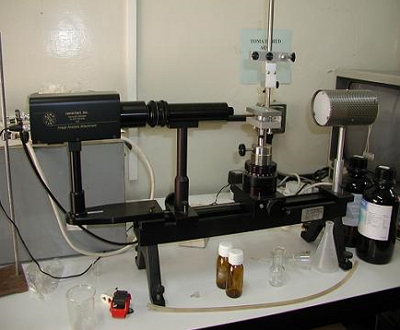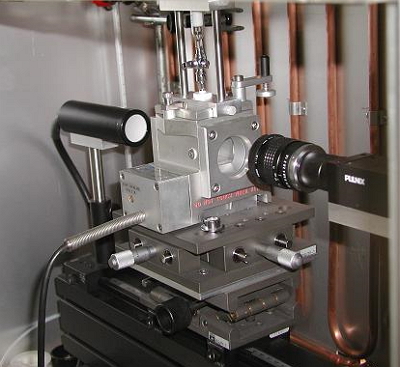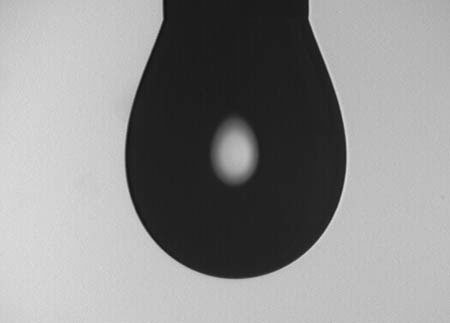ANGLES OF CONTACT. SURFACE AND INTERFACE TENSION
|
Description |

Figure 1. Contact angle measuring device
The physicochemical properties of the interfaces are of interest in various fields of technology where they play an important or even decisive role. Among these fields can be mentioned the manufacture of inks, phytosanitary products, detergents, oil recovery etc. Surface energy is a factor to be considered in technologies of biomedical interest such as implants and other materials that must be in contact with biological fluids. In these systems the contact angle is related to the wetting capacity, hydrophobicity of the surface and the ability adhesion of substances like proteins or other compounds on the surfaces. On the other hand to mention some application in the biomedical field of the superficial tension, it is necessary to emphasize the role that the pulmonary surfactants in the changes of surface tension dynamic and in balance in the physiology of the breathing.
The technique described in this technological offer allows measuring the contact angle and thereby calculating the free surface energy of solids from the corresponding state equations. The instrumentation allows measurements of static and dynamic surface and interfacial tension. The techniques described are readily modifiable so that various variables can be controlled which affect the surface tension and contact angle. This is the differential characteristic of commercial appliances where the measurement procedures are those used by the manufacturer. The technique requires analysis and processing of images that is done with various programs, some of them free such as ImageJ that allows programming macros or plugins to perform the task of determining the coordinates of the profile of the drop. The experimental data of the drop profile conform to the Young-Laplace equation which is solved by numerical methods.
|
How does it work |

Figure 2. Device for measuring surface tension and interfacial by the technique of the pending drop.
The contact angle is determined by depositing a drop of a liquid on a solid or on another non-miscible liquid. The drop is illuminated with diffused light to produce an image with sharp edges. The image of the drop is projected onto the objective of a microscope that has a graduated goniometer. The microscope has adapted a video camera that allows to reproduce the image on a monitor in black and white. The device consists of a small optical bench and two movers, one vertical and one horizontal. Also used for capturing images with the computer is an image acquisition card and programs for this purpose. This particular device uses a Data Translation DT3155 PCI card and an analog video camera. Other cards could be used instead or other types of cameras such as a digital USB camera that would allow you to do without the card. The devices are adaptable to new components from very different manufacturers that will allow the instruments to be updated at a reduced price.
The determination of surface or interfacial tension by analyzing the shape of the symmetrical axis-drop (ADSA) is performed by analyzing the shape of a drop of a liquid that hangs from the tip of a needle or tube, or which floats when the drop of the fluid is less dense than the outer phase, in this case the drop is obtained with a curved needle. The image of the drop is obtained with a video camera connected to a computer.
The device used for imaging is shown in Fig. 2 and consists of an optical bench, micrometric screw driven translators, a thermostatic chamber and a diffuse light source. An image capture card and programs are also used to obtain an image or sequence of images with several time ramps for studies of dynamic surface tension.
The images have been processed and analyzed in order to determine the coordinates of the drop profile. For this purpose it is necessary to calibrate the images and correct the data properly. Calibration is performed using spheres and cylinders of known measurements with micron precision. Several macros have been used for image capture and data processing, and programs that require some specific knowledge of them to adapt the experiment to particular problems. Fig. 3 gives an image of the drop pending as it is obtained with the video camera where the day and moment in which the measurement is made is indicated, this is interesting for studies of dynamic surface tension. The experimental data are adjusted to the theoretical data provided by the solution of the Young-Laplace equation. This equation is solved by numerical methods. Among other information, the parameter that is calculated from the adjustment is the surface tension and radius of curvature. The program also provides the volume and surface of the drop.
|
Advantages |

Figure 3. Image of the pending drop.
The determination of the interfacial tension solid vapor and liquid solid is important in a multitude of problems. Among the various existing methods, based on direct force measurement, contact angles, capillary penetration, flotation of films etc., the measurement of contact angles is the simplest method.
One of the advantages of using the ADSA technique to measure surface or interfacial tension is that it allows the use of small amounts of sample, which is ideal when using substances of high cost interest (eg in biotechnology).
It also allows to maintain clean surfaces, so that the results can be reproduced properly. Adsorption problems in the region separating the three phases will be avoided, which would distort surface or interfacial tension results, mainly in macromolecule and protein solutions. This is an elegant method of calculating surface tension, which has benefited from the computer developments that allow the automation, obtaining and processing of complicated images and calculations that would otherwise require a large amount of time that would make them unfeasible.
|
Where has it been developed |
The instrument of measures of contact angles is a commercial apparatus manufactured by Ramé-Hart, acquired from a project of the Ministry of Education of the Community of Madrid. The technique of measuring surface tension by the analysis of the shape of the drop (ADSA) has been developed in the Department of Physics-Chemistry and Farmaceutical Chemistry of the Faculty of Pharmacy of the Complutense University of Madrid. This technique is similar to the existing one in the Department of Chemical Engineering of the University of Berkeley. The surface tension and interfacial results obtained with this technique have been validated through the collaboration with the group of Prof. Neumann of the University of Ontario, pioneer in this field. Various scientific publications have included measures taken with the instruments described.
|
And also |
Contact angles are a parameter of interest in problems where the interface is important: detergency, flotation, wetting of surfaces, surface or interfacial tension of solids, analysis of surfaces of medical materials and adhesion problems of polymer or other surfaces. The surface and interfacial tension parameters are also of interest in the processes indicated above.
The adsorption of surfactants or other substances at the oil-water or air-water interface is very useful in various agriculture-related technologies, such as the use of pesticides, environmental problems, products such as paints, inks, petroleum, additives in processes of emulsification and solubilization etc. The ADSA technique allows the study of adsorption kinetics at the air / liquid and liquid / liquid interfaces. Finally from a basic point of view in theoretical studies of the mechanism and adsorption kinetics, superficially active substances are studied at the interfaces.
|
Contact |
|
© Office for the Transfer of Research Results – UCM |
|
PDF Downloads |
|
Classification |
|
Responsible Researcher |
Pedro A. Galera Gómez: galera@ucm.es
Department: Physics-Chemistry II (Pharmaceutical Physics-Chemistry)
Faculty: Pharmacy


